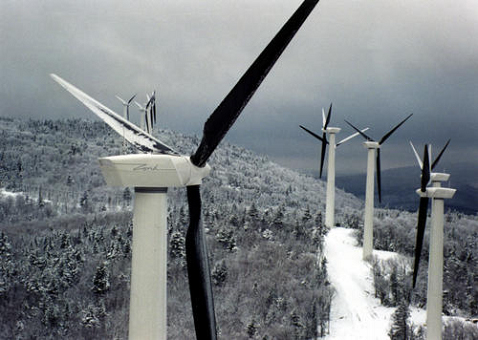The land give-away is staggering. Literally hundreds of thousands of hectares of the best wind farm sites have already been assigned to private developers. Yet because most of this land is in remote locations, the average British Columbian has no idea of the extent of the land giveaway.
Communities, which exist within these energy licence areas, have been largely unaware of the land-use applications and the impacts that might occur on local stewardship efforts.
Now it may have hit close to home.
With the fervour of a windstorm a division of one of Canada’s largest financial management corporations might be positioning itself to create a wind power grid in some of the Monashee’s most pristine and remote areas.
The Brookfield Power Wind Corporation of Gatineau, Quebec owner of the largest wind farm in Canada has made application to the Integrated Land Management Bureau for a license to install wind power monitoring towers on unsurveyed Crown land in numerous locations including the vicinities of Home, Ferry and Fish Lakes as well as West Bruar and Gunnar Creeks all located in the Cherryville area.
The applications appear to be speculating that there may be consistent winds generated from the Graystokes and Aberdeen Plateaus on the east slope of the Columbia watershed summit above the North Granby drainage.
Brookfield Power has developed and successfully operated hydroelectric power facilities for over 100 years. Their portfolio comprises of almost 3,900 megawatts of capacity and includes over 150 hydroelectric power generating stations located on 60 river systems and also includes 1 wind farm, and 2 thermal plants, principally in northeastern North America and Brazil.
The company is a division of Brookfield Asset Management Inc. a global asset manager focused on property, power and other infrastructure assets with approximately US$90 billion of assets under management. The corporation was in the news recently when they came very close to taking over the Canadian Pacific Railway.
Brookfield Asset has a massive portfolio of interests that includes power, timber and infrastructure that includes the construction of bridges and roads. A number of Brookfield’s facilities are owned in partnership with retail investors through 50% owned Great Lakes Hydro Income Fund (TSX:GLH.UN).
Today, Brookfield is one of the lowest cost producers of electricity in North America and recognized as one of the largest private owner-operators of low cost, renewable, hydroelectric power facilities.
Now the company has set its sights on British Columbia.
In October, the company announced that it had acquired two hydroelectric generating facilities in Northeast British Columbia from East Twin Creek Hydro Ltd. The two run-of-river facilities, which are located near the communities of McBride and Valemount, have a combined installed capacity of 7.4 megawatts and produce approximately 29 gigawatt hours of energy annually. All the power generated by the facilities is sold under long-term purchase agreements with B.C. Hydro.
Brookfield Power’s renewable power generation portfolio in BC, now includes five hydro stations on five river systems and the company is now targeting a major move into wind power.
In Ontario, the company is investing in the development of wind energy projects and has recently completed its 189 MW wind farm in Northern Ontario, the largest of its kind in Canada.
Last month the company announced that it closed a C$300 million financing deal in connection with its 189-MW Prince Wind Project through a wholly owned subsidiary, Brookfield Power Wind Prince Financial Corporation. Proceeds of the financing will be used to repay the existing construction credit facility for Prince Wind.
Prince Wind, the largest operating wind farm in Canada with 126 wind turbines situated on nearly 20,000 acres overlooking Lake Superior northwest of Sault Ste. Marie, is capable of producing enough clean, renewable energy to power 40,000 homes annually.
The wind farm was commissioned during the fourth quarter of 2006 and has been fully operational for one year. All the energy produced by Prince Wind is sold to the Ontario Power Authority under long-term power purchase contracts expiring between 2026 and 2028.
Presently Brookfield Power has a number of applications in the southern interior of BC for the testing of wind power. It remains uncertain as to whether there is potential for a full-scale wind farm in the Monashee.
Increasingly, energy from wind farms, like energy from run-of-the-river hydro projects, can be certified as "green." This means it can command a higher price in jurisdictions -- such as certain U.S. states -- where customers wish to purchase this form of energy for environmental reasons or where state governments have mandated that a specific percentage of energy sold within their jurisdictions must be "green."
That's why many of the same private energy developers that have acquired water licences at bargain basement prices have recently been scrambling to acquire land tenures on the very best wind farm sites in B.C.
This fall, the Okanagan Shuswap Land Resource Management Monitoring Committee began an examination of both the public process and the state of applications for independent power generation in the Okanagan Shuswap after it received questions and concerns regarding the future of transmission facilities in the region and the overlapping use of crown land and possible negative environmental impacts of such projects.
It will be interesting to see what’s discovered.
One would hope that logic will prevail and that we can encourage more local sustainable energy sources, while ensuring that local communities will benefit.
But probably most important when trying to devise new ways of creating energy, is that we solve our environmental problems without creating new ones.
(30)

